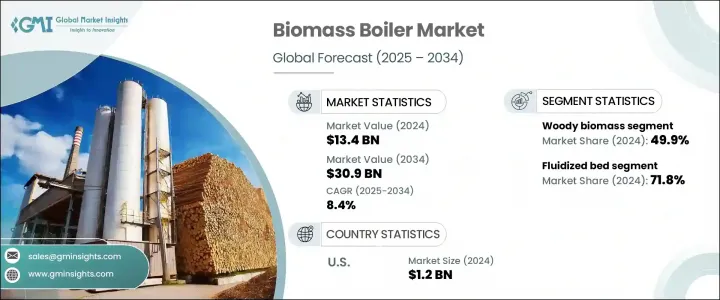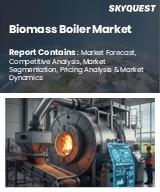
|
시장보고서
상품코드
1797870
바이오매스 보일러 시장 기회, 성장 촉진요인, 산업 동향 분석 및 예측(2025-2034년)Biomass Boiler Market Opportunity, Growth Drivers, Industry Trend Analysis, and Forecast 2025 - 2034 |
||||||
세계의 바이오매스 보일러 시장 규모는 2024년에는 134억 달러로 평가되었고, CAGR 8.4%를 나타내 2034년에는 309억 달러에 이를 것으로 전망됩니다.
배출량에 대한 우려가 증가하고 에너지 안보 요구가 증가함에 따라 화석 연료에서 더 깨끗한 난방 시스템으로의 전환이 가속화되고 있습니다. 저탄소 정책을 채택하고 탈탄소화를 추진하는 나라가 늘고 있는 가운데, 바이오매스 난방 시스템은 유기물을 효율적으로 이용하는 능력으로 인지도를 높이고 있습니다. 이 보일러는 기존의 연료 시스템을 대체하는 재생 가능한 대체 연료로서 열 생성과 폐기물 재사용의 두 가지 이점을 제공합니다. 상업, 주택, 산업 분야에서 도입이 진행되고 있는 이유는 친환경 기술의 촉진을 목적으로 하는 유리한 규제, 지속가능성의 의무화, 세제우대조치에 지지되어 있기 때문입니다. 이산화탄소 배출량과 에너지 자급에 대한 의식이 높아지면서 바이오매스 기반 난방 솔루션에 대한 투자를 촉진하고 있습니다.

바이오매스 보일러는 농업 잔류물, 목재 칩, 유기 폐기물과 같은 재생 가능한 원료를 사용하여 온수와 열을 생산하는 것으로, 기존 시스템과 유사한 기능을 가지면서 환경에 미치는 영향이 적습니다. AI를 탑재한 시스템, 특히 실시간 연소 관리를 제공하는 시스템에 대한 지지가 높아지고 있으며, 배출량을 삭감하면서 연료 변환 효율을 향상시키고 있습니다. 자동 연료 공급, 센서 조정, 적응 제어 기술은 프리미엄 유닛의 표준이 되고 있습니다. 시장은 또한 소규모에서 대규모까지 확장 가능한 배치를 가능하게 하는 모듈 설계 및 유동층 연소 기술에 대한 관심 증가를 목격하고 있습니다. 보다 엄격한 환경법을 준수하는 저 NOx 가열 장치에 대한 수요가 증가함에 따라 제품 혁신에 더욱 기여하고 있습니다. 또한 신재생에너지 크레딧, 보조금, 고정가격임베디드제도 등의 정부 프로그램이 첨단 바이오매스 시스템에 대한 설비투자를 직접 추진하고 있습니다.
| 시장 범위 | |
|---|---|
| 시작 연도 | 2024년 |
| 예측 연도 | 2025-2034년 |
| 시작 금액 | 134억 달러 |
| 예측 금액 | 309억 달러 |
| CAGR | 8.4% |
목질 바이오매스 분야는 2024년에 49.9%의 점유율을 차지했고 2034년까지 연평균 복합 성장률(CAGR)%를 나타낼 전망입니다. 임업 제품 및 목재 펠릿이 여러 지역에서 널리 사용 가능하다는 것은이 분야의 우위를 지원합니다. 현지 조달 연료는 운송 비용을 최소화하고 지역 에너지 자급률을 높입니다. 이 시스템은 안정적인 열 출력과 저렴한 가격으로 겨울이 길어지는 지역에서도 선호됩니다. 정책 입안자와 지자체가 조달 인센티브와 배출권을 제공함으로써 공공시설과 민간 시설 모두에서 목질 바이오매스 보일러의 도입이 가속화되고 있습니다.
스토커 유형의 바이오매스 보일러 부문은 2024년 23억 달러로 평가되었습니다. 열전병급(CHP) 플랜트에의 도입이 진행됨으로써, 전기와 열에너지의 동시 발전이 가능해져, 연료 이용 효율이 높아집니다. 연속 운전에 적합하며 다양한 유형의 연료에 적응할 수 있기 때문에 유틸리티과 산업 설비에서의 매력은 더욱 높아지고 있습니다. 분산형 에너지 발전에 기여하면 새로운 수익원을 개방하는 동시에 운전 유연성을 확보하고 송전망에 대한 의존도를 줄일 수 있습니다.
미국의 바이오매스 보일러 시장은 2024년에 86.4%의 점유율을 차지하고 12억 달러를 창출했습니다. 배출에 대한 의식 증가와 저렴한 청정 에너지 솔루션에 대한 관심 증가는 이 나라 시장 기세에 크게 기여하고 있습니다. 주 수준의 지원 정책과 그린 빌딩 관행의 확대는 특히 상업 캠퍼스, 공공 인프라, 에너지 집약형 산업에서 선진 보일러 시스템의 새로운 기회를 창출하고 있습니다. 또, 비전화 지역이나 농촌에서의 분산형 난방의 선호도, 한층 더 보급을 뒷받침하고 있습니다.
세계의 바이오매스 보일러 시장 경쟁 구도를 형성하는 주요 기업으로는 Hurst Boiler & Welding, Viessmann, DP CleanTech, Babcock & Wilcox Enterprises, ANDRITZ Group 등이 있습니다. 바이오매스 보일러 시장의 주요 기업은 여러 전략을 활용하여 발자국을 확대하고 시장에서의 존재감을 강화하고 있습니다. 각 회사는 일관되게 소규모 비즈니스와 유틸리티 규모를 모두 지원하는 모듈식 확장 가능한 시스템을 개발하고 있습니다. 각 회사는 환경 규제 강화에 대응하기 위해 AI 대응 제어 시스템과 저배출 연소 기술을 통한 제품 라인 업그레이드에 주력하고 있습니다. 연구개발에 대한 투자는 보다 연료에 유연하게 대응할 수 있는 시스템의 구축과 효율 향상을 위해 우선적으로 행해지고 있습니다. 신재생에너지 개발자 및 턴키 솔루션 제산업체와의 전략적 제휴는 종합적인 설치 및 유지보수 서비스를 제공하는 데 도움이 됩니다.
목차
제1장 조사 방법과 범위
제2장 주요 요약
제3장 업계 인사이트
- 업계 생태계 분석
- 원재료 가용성 및 조달 분석
- 제조 능력 평가
- 공급망의 탄력성과 위험요인
- 배전망 분석
- 규제 상황
- 업계에 미치는 영향요인
- 성장 촉진요인
- 업계의 잠재적 리스크 및 과제
- 성장 가능성 분석
- Porter's Five Forces 분석
- PESTEL 분석
- 바이오매스 보일러의 비용 구조 분석
- 가격 동향 분석
- 지역별
- 원료별
- 새로운 기회와 동향
- 디지털화와 인더스트리 4.0의 통합
- 신흥 시장에의 침투
- 투자분석과 재무정세
제4장 경쟁 구도
- 서론
- 기업의 시장 점유율 분석 : 지역별
- 북미
- 유럽
- 아시아태평양
- 중동 및 아프리카
- 라틴아메리카
- 전략적 대시보드
- 전략적 노력
- 주요 파트너십 및 협업
- 주요 M&A 활동
- 제품의 혁신과 발매
- 시장 확대 전략
- 경쟁 벤치마킹
- 파괴적 혁신과 지속가능성의 정세
제5장 시장 규모와 예측 : 원료별(2021-2034년)
- 주요 동향
- 목질 바이오매스
- 농업 폐기물
- 산업 폐기물
- 도시 잔류물
- 기타
제6장 시장 규모와 예측 : 제품별(2021-2034년)
- 주요 동향
- 스토커
- 유동층
제7장 시장 규모와 예측 : 용도별(2021-2034년)
- 주요 동향
- 주택용
- 상업용
- 산업용
제8장 시장 규모와 예측 : 지역별(2021-2034년)
- 주요 동향
- 북미
- 미국
- 캐나다
- 멕시코
- 유럽
- 프랑스
- 영국
- 폴란드
- 이탈리아
- 스페인
- 오스트리아
- 독일
- 스웨덴
- 러시아
- 아시아태평양
- 중국
- 인도
- 필리핀
- 일본
- 한국
- 호주
- 인도네시아
- 중동
- 사우디아라비아
- 이란
- 아랍에미리트(UAE)
- 나이지리아
- 남아프리카
- 라틴아메리카
- 아르헨티나
- 칠레
- 브라질
제9장 기업 프로파일
- ANDRITZ Group
- ARITERM
- Babcock &Wilcox Enterprises
- Binder Energietechnik
- Cheema Boiler
- DP Cleantech
- Forbes Marshall
- Froling Heizkessel
- Guntamatic Heiztechnik
- Hargassner GesmbH
- Hoval
- Hurst Boiler &Welding
- John Cockerill
- John Wood Group
- KwB Energiesysteme
- Maxtherm Boilers
- OkoFEN
- Prime Thermals
- Schmid Energy Solutions
- Sofinter
- Sugimat
- Transparent Energy Systems
- Thermax
- Thermodyne Boiler
- Treco
- VIESSMANN
The Global Biomass Boiler Market was valued at USD 13.4 billion in 2024 and is estimated to grow at a CAGR of 8.4% to reach USD 30.9 billion by 2034. Growing concerns over emissions and rising energy security needs are accelerating the transition from fossil fuels to cleaner heating systems. As more countries adopt low-carbon policies and push for decarbonization, biomass heating systems are gaining recognition for their ability to utilize organic materials efficiently. These boilers serve as a renewable alternative to conventional fuel systems, offering the dual benefit of heat generation and waste repurpose. Their increasing deployment across commercial, residential, and industrial sectors is supported by favorable regulations, sustainability mandates, and tax incentives aimed at promoting greener technologies. Heightened awareness of carbon footprints and energy independence is also prompting investments in biomass-based heating solutions, particularly in colder regions and off-grid areas where cost-effective, locally available fuels are essential.

A biomass boiler uses renewable feedstocks like agricultural residue, wood chips, and organic waste to produce hot water and heat, functioning similarly to a conventional system but with a lower environmental impact. Rising support for AI-powered systems, particularly those offering real-time combustion management, is improving fuel conversion efficiency while reducing emissions. Automated fuel feeding, sensor-based adjustments, and adaptive control technologies are becoming standard among premium units. The market is also witnessing growing interest in modular designs and fluidized bed combustion technologies that allow scalable deployment for both small- and large-scale operations. Increasing demand for low-NOx heating units in compliance with stricter environmental laws is further contributing to product innovation. Additionally, government programs, including renewable energy credits, grants, and feed-in tariffs, are directly boosting capital investments in advanced biomass systems.
| Market Scope | |
|---|---|
| Start Year | 2024 |
| Forecast Year | 2025-2034 |
| Start Value | $13.4 Billion |
| Forecast Value | $30.9 Billion |
| CAGR | 8.4% |
The woody biomass segment held a 49.9% share in 2024 and is poised to grow at a CAGR of 8% through 2034. The widespread availability of forestry by-products and wood pellets across several geographies is supporting the dominance of this segment. Locally sourced fuel minimizes transportation costs and enhances regional energy autonomy. These systems are also preferred in regions with prolonged winters due to their consistent heat output and affordability. Policymakers and municipal authorities offering procurement incentives and emissions credits are accelerating the deployment of woody biomass boilers in both public and private facilities.
The stocker-type biomass boiler segment was valued at USD 2.3 billion in 2024. Their increasing incorporation into combined heat and power (CHP) plants allows for simultaneous generation of electricity and thermal energy, making them highly efficient in terms of fuel utilization. Their suitability for continuous operation and adaptability to a wide range of fuel types further enhances their appeal across utilities and industrial setups. Their contribution to distributed energy generation is opening new revenue streams while ensuring operational flexibility and reduced grid dependency.
U.S. Biomass Boiler Market held 86.4% share in 2024, generating USD 1.2 billion. Rising awareness about emissions and growing interest in affordable clean energy solutions are key contributors to the market's momentum in the country. Supportive state-level policies and expansion of green building practices are creating new opportunities for advanced boiler systems, especially in commercial campuses, public infrastructure, and energy-intensive industries. The preference for decentralized heating in off-grid areas and rural regions is also driving further adoption.
Major companies shaping the competitive landscape of the Global Biomass Boiler Market include Hurst Boiler & Welding, Viessmann, DP CleanTech, Babcock & Wilcox Enterprises, and ANDRITZ Group. Top players in the biomass boiler market are leveraging several strategies to expand their footprint and reinforce their market presence. They are consistently developing modular and scalable systems tailored for both small-scale and utility-scale operations. Companies are focusing on upgrading product lines with AI-enabled control systems and low-emission combustion technologies to align with tightening environmental regulations. Investment in R&D is being prioritized to create more fuel-flexible systems and improve efficiency. Strategic collaborations with renewable energy developers and turnkey solution providers are helping to deliver comprehensive installation and maintenance services.
Table of Contents
Chapter 1 Methodology & Scope
- 1.1 Research design
- 1.2 Market estimates & forecast parameters
- 1.3 Forecast calculation
- 1.4 Data sources
- 1.4.1 Primary
- 1.4.2 Secondary
- 1.4.2.1 Paid
- 1.4.2.2 Public
- 1.5 Market definitions
Chapter 2 Executive Summary
- 2.1 Industry synopsis, 2021 - 2034
Chapter 3 Industry Insights
- 3.1 Industry ecosystem analysis
- 3.1.1.1 Raw material availability & sourcing analysis
- 3.1.1.2 Manufacturing capacity assessment
- 3.1.1.3 Supply chain resilience & risk factors
- 3.1.1.4 Distribution network analysis
- 3.2 Regulatory landscape
- 3.3 Industry impact forces
- 3.3.1 Growth drivers
- 3.3.2 Industry pitfalls & challenges
- 3.4 Growth potential analysis
- 3.5 Porter's analysis
- 3.5.1 Bargaining power of suppliers
- 3.5.2 Bargaining power of buyers
- 3.5.3 Threat of new entrants
- 3.5.4 Threat of substitutes
- 3.6 PESTEL analysis
- 3.6.1 Political factors
- 3.6.2 Economic factors
- 3.6.3 Social factors
- 3.6.4 Technological factors
- 3.6.5 Legal factors
- 3.6.6 Environmental factors
- 3.7 Cost structure analysis of biomass boiler
- 3.8 Price trend analysis
- 3.8.1 By region
- 3.8.2 By feedstock
- 3.9 Emerging opportunities & trends
- 3.9.1 Digitalization & industry 4.0 integration
- 3.9.2 Emerging market penetration
- 3.10 Investment analysis & financial landscape
Chapter 4 Competitive Landscape, 2025
- 4.1 Introduction
- 4.2 Company market share analysis, by region, 2024
- 4.2.1 North America
- 4.2.2 Europe
- 4.2.3 Asia Pacific
- 4.2.4 Middle East & Africa
- 4.2.5 Latin America
- 4.3 Strategic dashboard
- 4.4 Strategic initiatives
- 4.4.1 Key partnerships & collaborations
- 4.4.2 Major M&A activities
- 4.4.3 Product innovations & launches
- 4.4.4 Market expansion strategies
- 4.5 Competitive benchmarking
- 4.6 Innovation & sustainability landscape
Chapter 5 Market Size and Forecast, By Feedstock, 2021 - 2034 (USD Million & Units)
- 5.1 Key trends
- 5.2 Woody biomass
- 5.3 Agricultural waste
- 5.4 Industrial waste
- 5.5 Urban residue
- 5.6 Others
Chapter 6 Market Size and Forecast, By Product, 2021 - 2034 (USD Million & Units)
- 6.1 Key trends
- 6.2 Stocker
- 6.3 Fluidized bed
Chapter 7 Market Size and Forecast, By Application, 2021 - 2034 (USD Million & Units)
- 7.1 Key trends
- 7.2 Residential
- 7.3 Commercial
- 7.4 Industrial
Chapter 8 Market Size and Forecast, By Region, 2021 - 2034 (USD Million & Units)
- 8.1 Key trends
- 8.2 North America
- 8.2.1 U.S.
- 8.2.2 Canada
- 8.2.3 Mexico
- 8.3 Europe
- 8.3.1 France
- 8.3.2 UK
- 8.3.3 Poland
- 8.3.4 Italy
- 8.3.5 Spain
- 8.3.6 Austria
- 8.3.7 Germany
- 8.3.8 Sweden
- 8.3.9 Russia
- 8.4 Asia Pacific
- 8.4.1 China
- 8.4.2 India
- 8.4.3 Philippines
- 8.4.4 Japan
- 8.4.5 South Korea
- 8.4.6 Australia
- 8.4.7 Indonesia
- 8.5 Middle East
- 8.5.1 Saudi Arabia
- 8.5.2 Iran
- 8.5.3 UAE
- 8.5.4 Nigeria
- 8.5.5 South Africa
- 8.6 Latin America
- 8.6.1 Argentina
- 8.6.2 Chile
- 8.6.3 Brazil
Chapter 9 Company Profiles
- 9.1 ANDRITZ Group
- 9.2 ARITERM
- 9.3 Babcock & Wilcox Enterprises
- 9.4 Binder Energietechnik
- 9.5 Cheema Boiler
- 9.6 DP Cleantech
- 9.7 Forbes Marshall
- 9.8 Froling Heizkessel
- 9.9 Guntamatic Heiztechnik
- 9.10 Hargassner GesmbH
- 9.11 Hoval
- 9.12 Hurst Boiler & Welding
- 9.13 John Cockerill
- 9.14 John Wood Group
- 9.15 KwB Energiesysteme
- 9.16 Maxtherm Boilers
- 9.17 OkoFEN
- 9.18 Prime Thermals
- 9.19 Schmid Energy Solutions
- 9.20 Sofinter
- 9.21 Sugimat
- 9.22 Transparent Energy Systems
- 9.23 Thermax
- 9.24 Thermodyne Boiler
- 9.25 Treco
- 9.26 VIESSMANN
















